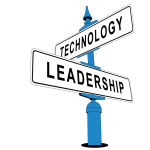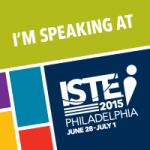Well, it has been a couple of days since I left Philly after an amazing conference. I said this on Twitter, but it bears repeating: #ISTE2015 was a life-changing event for me because it opened me up to the breadth and depth of EdTech. I had the opportunity to meet with so many people with influence and effect in our field. It was truly an honor to be in that position.
Now, I would love to take you through the whirlwind that was my experience at the conference, our board meeting, and the pre-conference I keynoted because it was something to behold. My experience is not a testament to my work, per se, but rather the importance ISTE has in the education community. However, if I went through every detail the Internet would break.
So, what I’d thought I do was talk about a few highlights and takeaways:
- #Futureready. For those of you who haven’t taken a look at this program run by the USDOE Office of Education Technology, in conjuction with several thought leaders in the field, really should. The ethos of creating schools and districts that think and plan for students’ needs in their futures rather than our present is the basis from which all of us should be operating. It’s a program that has applicability to all schools…all schools.
- Make. The idea that students should learn to solve problems, build, and be creative in a constructionist frame is concept that has taken our field by storm. There are so many ideas for conceptual and practical application of the maker movement that schools have no excuse for not even looking at the body of available materials. Push your school to think about this as Making is the basis of what we want learning to be.
- Data usage and privacy. I moderated a panel of experts on the topic that moved from collecting to using to protecting student data. This is an incredibly salient topic as the tools for using data are at our fingertips, yet we don’t take advantage of it. Yet, people are expecting educators to do so and to do so well. Pair that with the breaches of school networks we all know about (and those we don’t) and the topic becomes more important. Think about your data, end to end!
- Check out products and services. Every ISTE has an expo hall that daunts. It’s acres of products, vendors, services, startups, and everything in between. These are the resources we use in our classrooms and they need focused attention. I just wish I had more time.
- Find your tribe. I used to say network or connect. Now, the word is “tribe.” Those who align and share with that have the same ideals and passions while providing you a breadth of expertise and support. Be it twitter or face-to-face interactions, your tribe is perhaps your most valuable EdTech resource. During the conference, I worked to link more of my tribe through meetups with friends, twitter conversations, resource sharing, and a few get-togethers after hours. My tribe has grown quite a bit and with it my abilities to serve my school and ISTE. I would suggest engaging in real conversations that grow your tribe.
- Linkage. Our board did a great job of connecting with people, but there is more to do. We had a lot of great feedback that we were all attentive and approachable and people enjoyed taking selfies with us. But after talking with seasoned ISTE members and the new attendees, I realized that the board needs to continue its effort to fully serve the needs of the membership. Perhaps even take the time to connect these two groups, ensuring the history of our field is intact while supporting and mentoring those who will shape in the coming years.
- Teacher Ed and Evaluation. During our board meeting, we had the opportunity to meet with local professors, school administrators, and teacher ed students. In short, there is a big gap in training, especially in prepping teachers to use tech and libraries in teachings. I also served on a think-tank panel looking for solutions to this gap. This is a long standing problem with deeply rooted cultural and operational challenges, but I actually think that these meetings are helping. Also, if we can base some of our evaluation and training on ISTE standards, both in teacher prep and school level PD, we can have a unifying strand from entry to action.
- I can play. There is a line in Good Will Hunting where he talks about his ability to do complex math and science as Beethoven’s ability to “just play.” I am not going to self aggrandize to point where I think I am at that level, but I did surprise myself during the conference. My context and situation changed hour-by-hour and with that the messaging I needed to produce. I was often thrown into big speeches, thank yous, or, in the case of the final day, coming on stage for the closing keynote. I am not sure how or where it came from, but I seemed to be able to articulate and deliver coherently and appropriately. Evidently, I can play.
Now, of course there are million other things I am missing from the great people, the award winners, the keynotes, IGNITE and pitchfest, the sessions, the PLNs and Affiliates, the focus on Digital Equity, and everything else.
 But, it must be said that #ISTE2015 was amazing on all levels. As I said in the closing keynote, most people who I spoke to during the conference were positive and often went to the point of calling this one the best ISTE yet. To be a part of that as Chair-Elect and seeing the depth and breadth of ISTE was very special. I really feel honored and take deep responsibility for the work ahead.
But, it must be said that #ISTE2015 was amazing on all levels. As I said in the closing keynote, most people who I spoke to during the conference were positive and often went to the point of calling this one the best ISTE yet. To be a part of that as Chair-Elect and seeing the depth and breadth of ISTE was very special. I really feel honored and take deep responsibility for the work ahead.
What stories do you have to share?
I work as an Educational Technology consultant at International EdTech committed to helping schools use technology successfully. I frequently present at conferences on Educational Leadership, Learning Technology, IT, and Data Systems. I am also a a published author focusing on Educational Technology, International Education, and Leadership.








